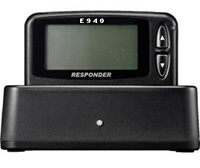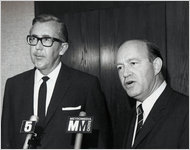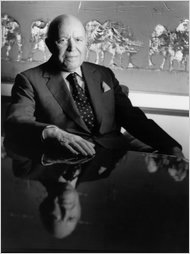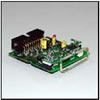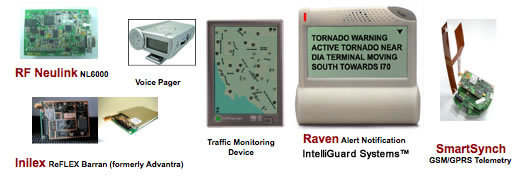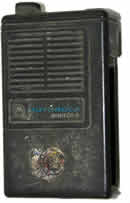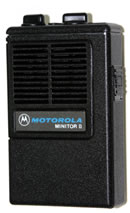BloostonLaw Telecom Update Published by the Law Offices of Blooston, Mordkofsky, Dickens, Duffy & Prendergast, LLP [Portions reproduced here with the firm's permission.] www.bloostonlaw.com |
| Vol. 13, No. 34 | August 27, 2010 |
 FCC Sets Tentative
Agenda For
Sept. 23 Open Meeting The FCC will consider the following items for its September 23 open meeting: TV White Spaces: A Second Memorandum Opinion and Order (MO&O) that the FCC hopes will create opportunities for investment and innovation in advanced Wi-Fi technologies and a variety of broadband services by finalizing provisions for unlicensed wireless devices to operate in unused parts of TV spectrum. E-Rate Broadband Order: An Order that the FCC hopes will improve connectivity for students and library patrons, and accelerate the National Broadband Plan’s goal of affordable access to 1 gigabit per second broadband at community anchor institutions across the country, by upgrading, modernizing, and streamlining the E-Rate program. E911 Location Accuracy Second R&O: A Report and Order the FCC hopes will enable a more effective emergency response system by establishing a timeline and benchmarks for wireless carriers to provide more granular E911 location information at either a county-based or PSAP-based geographic level. E911 Location Accuracy FNPRM and NOI: A FNPRN and NOI seeking to improve E911 location accuracy and reliability for existing and new voice communications technologies, including Voice over Internet Protocol (VoIP) and, consistent with the National Broadband Plan, to understand the ways in which voice communications enabled by broadband and next generation 911 technologies could support enhanced first response. BloostonLaw contacts: Hal Mordkofsky, Ben Dickens, Gerry Duffy, and John Prendergast. |
 INSIDE THIS ISSUE - Court partially invalidates certain auction bid credit rules; declines to overturn AWS, 700 MHz auctions.
- FCC provides instructions, seeks comment on high cost support reclamation.
- Clients should monitor ETC designation, ETC desig. transfer petitions RE: Verizon-Alltel transactions.
- FCC launches wireless HAC proceeding to ensure access to new technology.
- FCC proposes HAC fines.
|
Court Partially Invalidates Certain Auction Bid Credit Rules; Declines To Overturn AWS, 700 MHz Auctions In a 53-page ruling that found “serious” deficiencies in the FCC’s rulemaking (yet was met with sighs of relief from the Commission), the 3rd U.S. Circuit Court of Appeals in Philadelphia partially vacated certain portions of the Designated Entity (DE) rules that were adopted in 2006. The ruling also denied a request by Council Tree Communications to rescind the results of the Advanced Wireless Services (AWS) Auction No. 66 and 700 MHz Auction No. 73, since this would involve unwinding trans-actions worth more than $30 billion and potentially disrupt service to untold numbers of customers. A three-judge panel of the Court agreed with Council Tree and its co-petitioners that the FCC had acted in an arbitrary and capricious manner by adopting the “50% impermissible material relationship rule” without giving the public adequate notice and opportunity to comment. This rule was adopted on a rush basis in the lead-up to the AWS-1 auction. The Court likewise held that the Commission had failed to provide the necessary notice and opportunity to comment before extending the bid credit ”unjust enrichment” repayment period from five years to ten. The Court upheld (though just barely) the 25% “attributable material relationship” rule, which the petitioners had challenged as likely to chill small businesses’ access to capital. Impermissible Material Relationship Rule
Just ahead of the AWS auction, the FCC adopted two “material relationship” rules, which were supposed to close the loophole that had allowed certain large carriers to gain access (via spectrum leases) to licenses won with small business bid credits in prior auctions. The 25% attributable material relationship rule provides that, if a DE leases or resells (including at wholesale) more than 25% of its spectrum capacity to any single lessee or purchaser, it must add that lessee’s or purchaser’s revenues to its own to determine its continued eligibility for bid credits. Thus, if an auction winner leases to another small business, there is a good chance that it will not lose its bid credits. In contrast, the 50% impermissible material relationship rule makes license applicants or holders completely ineligible for bid credits if they lease or resell (including at wholesale) more than 50% of their spectrum capacity, even if the spectrum is leased to one or more small businesses. Moreover, the impermissible material relationship rule robs the auction winner of its bid credits even if it leases its spectrum to multiple entities, e.g., leasing only 10% of spectrum capacity to five different small businesses. The Court found this aspect very troubling. Unjust Enrichment Rule
The “unjust enrichment” rule provides that, if a designated entity wins bid credits at auction, but then loses its designated entity status by, e.g., merging with a large company or entering into an attributable spectrum lease, it must repay its bid credits to the government, with inter-est. The original unjust enrichment rule provided that a designated entity must maintain its bid credit eligibility for five years; and over the course of the five years, the re-payment obligation was reduced, so that a loss of bid credit eligibility in the fifth year would only require a re-payment of 25% of the bid credit amount. However, ahead of the AWS auction, the FCC decided to extend the unjust enrichment period to 10 years, over the objection that this would make it more difficult for small businesses to attract investors and lenders; and the FCC decided that, while the repayment obligation would scale down in years 6 through 10, the licensee would have to pay back the entire bid credit amount if it had not yet met its build out obligations at the time it lost its bid credit eligibility.
Under the Administrative Procedure Act (APA), federal agencies must publish either the terms or substance of the proposed rule or a description of the subjects and issues involved. The substance of an agency’s final rule must not stray too far from the description contained in the initial notice, or the public will have been deprived of a meaningful opportunity to comment on the proposed rule. Council Tree, an investor in DEs, had urged the FCC to place restrictions on grants of DE status to applicants having certain “material relationships” with large in-region incumbent wireless providers. However, the rules ultimately adopted by the Commission prohibited DEs from entering into spectrum lease and/or wholesale arrangements with any company, even another DE or the licensee’s subsidiaries and affiliates (i.e., situations that do not raise the same competitive concerns as large in-region incumbents). The 3rd Circuit’s decision to vacate the 50% impermissible relationship rule will mean (for the time being) that DEs will have greater freedom to lease or wholesale their spectrum, subject to revenue attribution should they lease or wholesale more than 25% of their spectrum to a single entity. Vacating the 10-year unjust enrichment rule will mean that DEs’ repayment obligations will once again be governed by the previous 5-year schedule. The FCC will need to issue a Notice of Proposed Rule Making and seek public comment if it wants to reinstate its material relationship and unjust enrichment rules vacated by the Court. If the vacated rules are re-adopted by the Commission, it may try to apply such rules retroactively (i.e., to prior auctions, and to transactions and arrangements that have been implemented in the meantime). It is possible to retroactively apply newly adopted rules. However, the FCC must balance the need for retroactive application against the mischief that would be caused by retroactive application. Entities that won licenses in spectrum auctions since 2006 would benefit significantly if the impermissible material relationship and 10-year unjust enrichment rules are NOT applied retroactively, if they are readopted. Our firm’s clients — and especially companies that are DEs and that won AWS and/or 700 MHz licenses in re-cent FCC auctions — will want to file comments to ensure that any new rules are clearly written and that DEs have the maximum flexibility to enter into spectrum leasing and/or wholesale arrangements without jeopardizing their DE status. They will also want to oppose any effort by the FCC to impose the new rules retroactively, to Auctions 66 or 73 (or other completed auctions). BloostonLaw contacts: Hal Mordkofsky, John Prendergast and Cary Mitchell FCC Provides Instructions, Seeks Comment On High Cost Support Reclamation In an Order and Notice of Proposed Rulemaking (NPRM), the FCC noted that Verizon Wireless and Sprint Nextel, in separate transactions in 2008, each committed to surrender their high-cost universal service support over five years, but those commitments have yet to be implemented. The FCC said that Corr Wireless Communications has asked that any support reclaimed from Verizon Wireless and Sprint Nextel be redistributed to other competitive eligible telecommunications carriers (ETCs). In this order the FCC (a) provides instructions for implementing the commitments of Verizon Wireless and Sprint Nextel; (b) holds that the surrendered support need not be redistributed to other competitive ETCs in all cases; and (c) directs that the surrendered support be reserved as a potential down payment on proposed broadband universal service reforms as recommended by the National Broadband Plan, including to index the E-rate fund-ing cap to inflation to enhance broadband opportunities for children, teachers, schools, and libraries; support a Mobility Fund to provide wireless broadband service in areas that lack coverage; improve utilization of the Rural Health Care program to advance telemedicine in rural areas across the country, including Tribal lands; and, in the long term, directly support broadband Internet ser vic-es for all Americans. The FCC posits that, in addition to accelerating universal access to broadband, this approach to implementing Verizon Wireless’ and Sprint Nextel’s commitments also reduces payments that support potentially duplicative legacy voice services and stabilizes consumer contributions to the universal service fund. In the NPRM that accompanies this order, the FCC seeks comment on permanently amending its rules to facilitate efficient use of reclaimed excess high-cost sup-port. In addition, the FCC seeks comment on a proposal to modify its rules to reclaim legacy support surrendered by a competitive ETC when it relinquishes ETC status in a particular state. Comments on this WC Docket No. 05-337 NPRM will be due 21 days after publication of the item in the Federal Register, and replies will be due 14 days thereafter. BloostonLaw contacts: Ben Dickens, Gerry Duffy, and Mary Sisak. Clients Should Monitor State ETC Designation, ETC Status Transfer Petitions RE: Verizon-Alltel Transactions It recently has come to our attention that Verizon, AT&T, and third parties involved in acquiring wireless licenses, formerly held by Alltel, are in the process of seeking State eligible telecommunications carrier (ETC) designation, and, in AT&T’s case, federal ETC designation relating to tribal areas. Our clients are urged to monitor any such State proceedings, involving wireless ETC support, and in particular Alltel’s former ETC support, that have significantly contributed to the growth of the federal high cost fund. The FCC has previously noted that Alltel was the single largest recipient of federal high cost fund proceeds. We will be glad to help our clients and their local counsel analyze the impact of any State ETC designation petitions associated with these referenced transactions. BloostonLaw contacts: Ben Dickens, Gerry Duffy, and Mary Sisak. FCC Launches New Open Internet Public Notice The FCC has released a Public Notice to inquire further into two “underdeveloped issues” in the Open Internet proceeding it launched in 2009. The first is the relation-ship between open Internet protections and services that are provided over the same last-mile facilities as broad-band Internet access service (commonly called “managed” or “specialized” services). The second is the application of open Internet rules to mobile wireless Internet access services, which have unique characteristics related to technology, associated application and device markets, and consumer usage. The 2009 Notice of Pro-posed Rulemaking (NPRM) raised both of these issues but addressed them in less detail than many other issues (including the FCC’s Internet Policy Statement), and the Commission believes its analysis would benefit from further development of these issues in the record. There-fore, it is raising them in a further inquiry in this Public Notice. Specialized Services In the NPRM, the Commission recognized that broad-band providers may provide other services over the same last-mile facilities used to provide broadband Inter-net access service. The FCC said these services may drive additional private investment in networks and pro-vide consumers new and valued services. However, there appear to be three general areas of concern about how to maintain the investment-promoting benefits of specialized services while protecting the Internet’s open-ness: (1) Bypassing Open Internet Protections: The FCC said open Internet protections may be weakened if broadband providers offer specialized services that are substantially similar to, but do not technically meet the definition of, broadband Internet access service, and if consumer protections do not apply to such services. A similar concern may arise if specialized services are integrated into broadband Internet access service; for example, if a broadband provider offers broadband Internet access service bundled with a “specialized service” that provides prioritized access to a particular website. (2) Supplanting the Open Internet: The FCC said broadband providers may constrict or fail to continue expanding the network capacity allocated to broadband Internet access service in order to provide more capacity for specialized services. If this occurs, and particularly if one or more specialized services serve as substitutes for the delivery of content, applications, and services over broadband Internet access service, the open Internet may wither as an open platform for competition, innovation, and free expression.
Anti-competitive Conduct: The FCC said broadband providers may have the ability and incentive to engage in anti-competitive conduct with respect to specialized ser-vices, particularly if they are vertically integrated providers of content, applications, or services; or if they enter into business arrangements with third-party content, application, or service providers concerning specialized service offerings. Such discriminatory conduct could harm competition among, and private investment in, con-tent, application, and service providers. The FCC said these concerns, particularly the second and third, may be exacerbated by worries that due to limited choice among broadband Internet access service providers, consumers may not be able to effectively exercise their preferences for broadband Internet access service (or content, applications, or services available through broadband Internet access service) over specialized services. The FCC said there appear to be at least six general policy approaches to addressing these concerns while promoting private investment and encouraging the development and deployment of new services that benefit consumers. These approaches could be employed alone or in combination: (A) Definitional Clarity: Define broadband Internet access service clearly and perhaps broadly, and apply open Internet rules to all forms of broadband Internet access service. Specialized services would be those services with a different scope or purpose than broad-band Internet access service (i.e., which do not meet the definition of broadband Internet access service), and would not be subject to the rules applicable to broadband Internet access service. But such services could be ad-dressed through one or more of the below policy approaches, or, alternatively, the Commission could ad-dress the policy implications of such services if and when such services are further developed in the market. (B) Truth in Advertising: Prohibit broadband providers from marketing specialized services as broadband Internet access service or as a substitute for such ser-vice, and require providers to offer broadband Internet access service as a stand-alone service, separate from specialized services, in addition to any bundled offerings. (C) Disclosure: Require providers to disclose information sufficient to enable consumers, third parties, and the Commission to evaluate and report on specialized services, including their effects on the capacity of and the markets for broadband Internet access service and Inter-net-based content, applications, and services. The Commission or Congress could then take action if necessary. (D) Non-exclusivity in Specialized Services: Require that any commercial arrangements with a vertically-integrated affiliate or a third party for the offering of specialized services be offered on the same terms to other third parties. (E) Limit Specialized Service Offerings: Allow broad-band providers to offer only a limited set of new specialized services, with functionality that cannot be provided via broadband Internet access service, such as a tele-medicine application that requires enhanced quality of service. (F) Guaranteed Capacity for Broadband Internet Access Service: Require broadband providers to continue providing or expanding network capacity allocated to broadband Internet access service, regardless of any specialized services they choose to offer. Relatedly, prohibit specialized services from inhibiting the performance of broadband Internet access services at any given time, including during periods of peak usage.
The FCC seeks comment on each of these concerns and suggested policy responses, as well as any other concerns or policies regarding specialized services that the Commission should consider. Which policies will best protect the open Internet and maintain incentives for private investment and deployment of innovative services that benefit consumers? In addition, the FCC seeks comment on whether specialized services provided over mobile wireless platforms raise unique issues. Application of Open Internet Principles to MOBILE Wireless platforms The NPRM seeks comment on “how, to what extent, and when” openness principles should apply to mobile wire-less platforms, with a particular emphasis on furthering innovation, private investment, competition, and freedom of expression. In light of developments since the issuance of the NPRM, the FCC believes it is now appropriate to update the record on certain questions related to the application of openness principles to wireless. Mo-bile broadband providers such as AT&T Mobility and Leap Wireless (Cricket) have recently introduced pricing plans that charge different prices based on the amount of data a customer uses. The FCC says the emergence of these new business models may reduce mobile broad-band providers’ incentives to employ more restrictive network management practices that could run afoul of open Internet principles. Additionally, the FCC said that Verizon and Google issued a proposal for open Internet legislation that would exclude wireless, except for pro-posed transparency requirements. Transparency
The FCC seeks comment on what disclosure requirements are appropriate to ensure that consumers and content, application, service, and device providers can make informed choices regarding use of mobile broad-band networks. What information should be disclosed about device and application requirements and certification processes? Are there any existing models that could provide guidance for shaping such rules? Devices
The FCC seeks further comment on the ability of new technologies and business models to facilitate non-harmful attachment of third-party devices to mobile wire-less networks. Can adherence to industry standards for mobile wireless networks ensure non-harmful technical interoperability between mobile broadband devices and networks? Will deployment of next-generation technologies (e.g., LTE) further facilitate interoperability? To the extent that compliance with technical standards needs to be validated through laboratory testing, could such test-ing be conducted through independent authorized test centers? Were the Commission to require mobile providers to allow any non-harmful device to connect to their network, subject to reasonable network management, how would mobile broadband provider conduct have to change, if at all, in light of existing device certification programs? As noted above, some mobile providers have introduced usage-based data pricing. To what extent do these business models mitigate concerns about congestion of scarce network capacity by third-party devices? Applications
The FCC seeks comment on how best to maximize consumer choice, innovation, and freedom of expression in the mobile application space, while ensuring continued private investment and competition in mobile wireless broadband services. To what extent should mobile wire-less providers be permitted to prevent or restrict the distribution or use of types of applications that may intensively use network capacity, or that cause other network management challenges? Is the use of reasonable net-work management sufficient, by itself or in combination with usage-based pricing, to address such concerns? Should mobile wireless providers have less discretion with respect to applications that compete with services the provider offers? How should the ability of developers to load software applications onto devices for development or prototyping purposes be protected? The FCC also seeks comment on the extent to which certain application distribution models—such as a mobile broadband Internet access service provider acting as both a network operator and an app store provider/curator—may affect consumer choice. If providers were to be prohibited from denying or restricting access to applications in their capacity as network providers, should they nevertheless have discretion regarding what apps are included in app stores that they operate? Are there safe-harbor criteria that, if met by a provider, would ameliorate potential concerns? For example, if a provider’s customer had a choice of several app store providers that offered applications that could be downloaded onto the customer’s mobile device, would that adequately mitigate concerns about potentially anti-competitive or anti-consumer effects of a provider excluding applications from its own app store? Finally, the FCC seeks comment on how differences between web-based and native applications should inform our analysis. Should a mobile provider have more discretion to restrict consumers’ downloading and/or use of native applications than they should with respect to web-based applications? Comments in this GN Docket No. 09-191 and WC Docket No. 07-52 proceeding will be due 30 days after publication of the item in the Federal Register, and replies will be due 25 days thereafter. BloostonLaw contacts: Hal Mordkofsky, Ben Dickens, Gerry Duffy, and John Prendergast. FCC Launches Wireless HAC Proceeding To Ensure Access To New Technology In today’s Federal Register, the FCC published comment dates for its Further Notice of Proposed Rulemaking (FNPRM) seeking comment on revisions to its wireless hearing aid compatibility rules. The Commission is initiating this proceeding to ensure that consumers with hear-ing loss are able to access wireless communications ser-vices through a wide selection of devices without experiencing disabling interference or other technical obstacles. In this FNPRM, the Commission seeks comment on potential changes to its hearing aid compatibility (HAC) rules in three respects. First, the Commission proposes to extend the scope of the rules beyond the current category of Commercial Mobile Radio Service (CMRS) to include handsets used to provide wireless voice communications over any type of network among members of the public or a substantial portion of the public. The Commission seeks comment on this proposal, on whether considerations of technological feasibility or marketability prevent application of its HAC requirements to any class of these handsets, and on what transition period is appropriate for applying the requirements to newly covered handsets. Second, the Commission seeks further comment on whether to extend its in-store testing requirement beyond retail stores owned or operated by service providers to some or all other retail outlets. Third, the Commission seeks comment on whether to extend to all circumstances the ability to meet HAC standards for radio frequency (RF) interference reduction for GSM operations in the 1900 MHz band through software that enables the user to reduce maximum power output by up to 2.5 decibels (dB). Comments in this WT Docket No. 07-250 proceeding are due October 25, and replies are due November 22. The FNPRM was released in conjunction with the FCC’s HAC Policy Statement and Second Report and Order (effective October 8). In these documents, the Commission affirms that its HAC rules must provide people who use hearing aids and cochlear implants with continuing access to the most advanced and innovative technologies as science and markets develop, while maximizing the conditions for innovation and investment. The Commission also clarifies that its HAC rules cover customer equipment that contains a built-in speaker and is designed to be typically held to the ear, adopts a streamlined procedure for amending its rules to incorporate an anticipated revision of the HAC technical standard that will make it generically applicable across frequency bands and interface modes, and extends its dis-closure requirements to provide consumers with information about multi-band and multi-mode phones that operate in part over bands or modes for which technical standards have not been established. In order to ensure that people with hearing loss will have access to new and popular models, while continuing to protect the ability of small companies to compete and to foster innovation by new entrants, the Commission modified the de minimis exception in its existing rule so that companies that are not small entities will be required to offer at least one hearing aid-compatible model after a two-year initial period. In recognition of specific challenges that this rule change will impose for handsets operating over the legacy GSM air interface in the 1900 MHz band, the Commission permits companies that will no longer qualify for the de minimis exception to meet hearing aid compatibility requirements by installing soft-ware that enables customers to reduce the power output by a limited amount for such operations. The Commission also amends its rules requiring manufacturers to deploy hearing aid-compatible handsets so that they ap-ply to handsets sold through all distribution channels, and not only through service providers. BloostonLaw contacts: Hal Mordkofsky, John Prendergast, and Cary Mitchell. FCC Proposes HAC Fines Against 3 Tier III Carriers The FCC recently issued separate $15,000 Notices of Apparent Liability for Forfeiture (NALs) against three GSM-based Tier III CMRS carriers for failing to offer consumers the required minimum number or percentage of digital wireless handsets that meet or exceed the RF interference standards for hearing aid compatibility. We remind clients of the current HAC handset deployment requirements, and emphasize the need for service providers to maintain accurate monthly records of their HAC handset offerings. The next round of HAC reports for CMRS service providers (including carriers and resellers) will be due Monday, January 17, 2011, and with end-of-year holidays around the corner, we strongly recommend that carriers confirm now that they have at all times been offering the required number (or percentage) of hearing aid compatible hand-sets, and that their record keeping systems are in place. The FCC’s HAC rules increased the required number of compliant handsets starting last year, and will continue to require the addition of compliant handsets through next year. BloostonLaw contacts: Hal Mordkofsky, John Prendergast, Cary Mitchell, and Bob Jackson. COMMENT DATES SET FOR PROCEEDING TO RE-MOVE BARRIERS TO USE OF SPECTRUM FOR WIRELESS BACKHAUL: The FCC has set comments dates for its proceeding to remove regulatory barriers to the use of spectrum for wireless backhaul and other point-to-point and point-to-multipoint communications. This proceeding is designed to surface ways to increase efficient use of spectrum for backhaul, especially by up-dating regulatory classifications that may not have kept pace with the evolution of converged digital technologies. Providing for the more flexible use of microwave frequencies for backhaul may help promote access to backhaul solutions that are critical to the deployment of wireless broadband and other services. The proposed rule changes may be particularly beneficial to rural areas, where wireline alternatives may not exist. The proposed rules should increase opportunities for all users of point-to-point and point-to-multipoint services, while protecting established license holders who are already using these bands. As an initial matter, the FCC believes 750 megahertz in the 13 gigahertz range and below can be made flexibly usable for broadband backhaul. Comments in this WT Docket Nos. 10-153, 09-106, and 07-121 proceeding are due October 25, and replies are due November 22. BloostonLaw contacts: Hal Mordkofsky, John Prendergast, and Cary Mitchell. FCC EXTENDS CERTAIN TRS WAIVERS: The FCC has extended for an additional year current waivers of certain Telecommunications Relay Services (TRS) mandatory minimum standards for Video Relay Service (VRS) and Internet Protocol Relay (IP Relay). The waived TRS mandatory minimum standards are: One-line voice carry over (VCO); VCO-to-teletypewriter (TTY); VCO-to-VCO; one-line hearing carry over (HCO); HCO-to-TTY; HCO-to-HCO; call release; speech-to-speech (STS); pay-per-call (900) calls; types of calls; and equal access to interexchange carriers requirements. The Commission also extends for one year a requirement for default Internet-based TRS providers that are unable to meet such standards for newly-registered Internet-based TRS users who port their customer premises equipment (CPE) from a former default provider. The Commission extends the waivers for one year because the record demonstrates that it is technologically infeasible for VRS and IP Relay providers to offer these services at this time. All of these waivers are conditioned on the filing of a report, due April 16, 2011, addressing whether it is necessary for the waivers to remain in effect. The waivers of certain TRS mandatory minimum standards for VRS and IP Relay will expire on July 1, 2011, or until the Commission addresses pending petitions regarding CPE portability, which ever comes first. (CG Docket No. 03-123; DA 10-1235.) BloostonLaw contacts: Ben Dickens, Gerry Duffy, and Mary Sisak. PROPOSED TOWER BAN COULD BE TROUBLE FOR CARRIERS: AGL Magazine is reporting that the Town of Hempstead, New York plans to ban additional cell towers within 1,500 feet of homes or schools. This action is op-posed by carriers such as T-Mobile and NextG Next-works, which have installed a number of towers in the affected areas. At the center of the controversy is a T-Mobile plan to erect a tower at the North Merrick Library, according to AGL. The structure would be disguised as a 50-foot flagpole and would help to eliminate coverage gaps in the North Merrick area. The library would receive $18,000 annually to lease the land. The initial announcement was made before nearly 40 people at the library during a meeting of the North Merrick Civic Association. But then the word spread, AGL reported, and the citizens rallied against the placement of the tower. A T-Mobile representative has defended the library cell tower with an engineering report stating the proposed installation will contribute less than .052 percent of the maxi-mum permissible level of RF exposure to the people in the library, and less than .166 percent within the surrounding community. But the jury is still out. If Hempstead is successful in putting its ban into place, it could make it difficult for wireless carriers to compete, especially smaller carriers that cannot always afford to be first to market. While Section 332 of the Communications Act bans state and local actions that would have the effect of precluding wireless service to a given community, this has been interpreted by certain courts as protect-ing only the first service provider in a community. Once the first service to the community is established, these courts have held that the Act does not guarantee access for subsequent providers. This trend may signal the need to amend Section 332 so as to foster competition; and it may in the meantime require smaller wireless carriers to think hard about adapting their buildout plan so that they are first to market in key coverage areas, to eliminate the risk that they fall victim to a similar tower ban. BloostonLaw contacts: Hal Mordkofsky, John Prendergast, Cary Mitchell and Richard Rubino.  This newsletter is not intended to provide legal advice. Those interested in more information should contact the firm. |



 RICHARDSON — Private-equity firm TA Associates has sold MetroPCS Communications (NYSE: PCS) stock worth $3.29 million, according to SEC filings.
RICHARDSON — Private-equity firm TA Associates has sold MetroPCS Communications (NYSE: PCS) stock worth $3.29 million, according to SEC filings.







 Apple
Apple 


